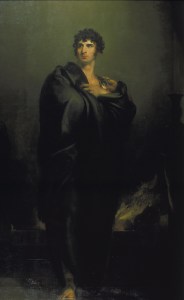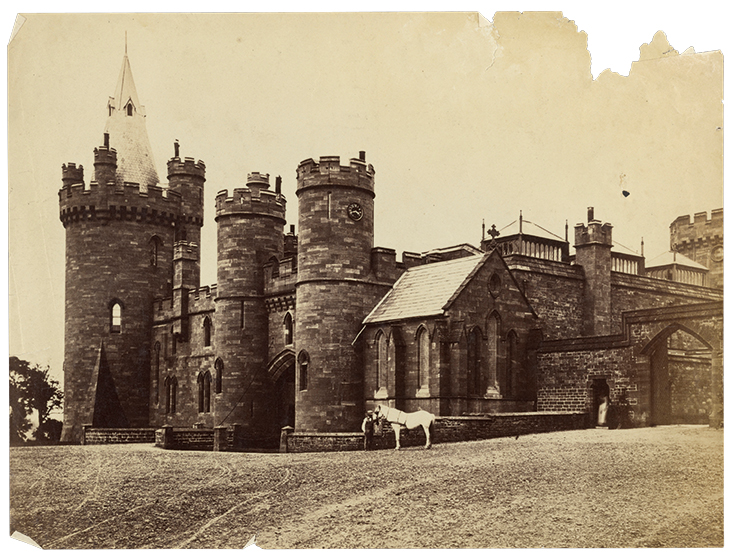From the September 2021 issue of Apollo. Preview and subscribe here.
Rosemary Hill begins her account of Romantic antiquarianism with Thomas Carlyle’s observation that the past was inhabited not by ‘abstractions’ and ‘theorems’ but by ‘living men […] with colour in their cheeks, with passion in their stomach, and the idioms, features and vitalities of very men’. It’s an insight that echoes throughout this absorbing study of a generation of men, and sometimes women, who helped shape a more democratic and inclusive vision of British history at the dawn of the 19th century. In their eyes, all epochs had their own dignity and interest, just as all traces from the past had potential value.
The Antiquary (c. 1827), Richard Parkes Bonington. © The Trustees of the Wallace Collection

These antiquarians were proud to uphold traditions derived from earlier luminaries such as William Camden, William Dugdale and John Aubrey, who, in the wake of Reformation and Civil War, had pioneered the study of Britain’s shattered material past. But the Romantic generation in around 1800 were pioneers in salvaging the medieval heritage (considered by many Georgian writers irredeemably ‘barbaric’), as well as conserving the traces of vanished customs and lifestyles. Their obsession with lost worlds exposed them to ridicule; in popular culture the antiquary was a dreamer who, as depicted by Richard Parkes Bonington in c. 1827, bore a strong resemblance to Don Quixote, ‘a melancholic Everyman’. The blend of nostalgia, erudition and fantasy placed antiquarians at the heart of the Romantic sensibility, as they found a kind of poetry in their work of cultural retrieval.
Time’s Witness retraces the antiquarians’ journey into the past through the revolutions of the present, showing how intimately British scholars were tied to events on the Continent. Hill is an elegant stylist and vivid storyteller, and her account brims with anecdotes gathered from the little-known papers of her protagonists. We follow the Norfolk banker Dawson Turner’s travels through post-revolutionary Paris, stop off at the Louvre and Alexandre Lenoir’s museum of French monuments, and find John Gage scouring the field of Waterloo for memorabilia. The interest of such men in the origins of Englishness prompted a new fascination in the 1820s for the archaeology of Normandy, thereby creating a network of cross-Channel intellectual exchange. The fascination with local history did not impede, but rather eased, British antiquarians’ engagement with France, from where they imported some of their prized collectables. Lenoir grumbled in the 1830s about ‘the gulf called England, where all our works of art now disappear’.
John Philip Kemble (1757–1823) as Coriolanus (1798), Thomas Lawrence. Guildhall Art Gallery, London

Figures such as Turner and Gage firmly contradict Walter Scott’s affectionate caricature of the antiquarian as Dryasdust. Indeed, antiquarian concerns nourished many of the most vital cultural experiments in the period, whether novels, plays or even coronations, with Scott in the thick of them all. Hill’s brilliant chapter on the ‘theatrical antiquary’, represented by figures such as Thomas Dibdin and James Robinson Planché, examines how historical reconstruction became spectacular, not least in the staging of Shakespeare. The desire to touch, taste and live with history produced some wonderfully outlandish buildings, from Abbotsford in Scotland, and Lowther Castle in Westmorland, through to Samuel Meyrick’s ‘romance in stone’ at Goodrich Court, Herefordshire, each place stuffed with curios, stained glass, ivories, armour and ‘oaken’ furnishings. ‘In the Romantic interior,’ Hill writes, ‘time was not so much suspended as rearranged to suit the inhabitant.’
Not all elements of antiquarian culture were so genial or playful. (Scott described rankling antiquaries as ‘bitchiferous’.) There were fierce polemics, many of which hinged on Britain’s Catholic past. The historian John Lingard outraged opinion in his unflattering account of the cynicism behind the Henrician Reformation. In the Romantic imagination things and places were valued primarily for the associations they generated and their emotive appeal. In navigating such hazy criteria of authenticity, Hill sketches sympathetic portraits not just of deluded collectors but also some brazen confidence tricksters. The influential Vestiarium Scoticum, published in 1842, was presented as a 17th-century history of tartan, but today is recognised as flagrant forgery. It was the brainchild of the brothers John and Charles Allen, adventurers who styled themselves ‘the Sobieski Stuarts’ and proclaimed their descent from Bonnie Prince Charlie.
Goodrich Court (c. 1860–80), unknown artist. J. Paul Getty Museum, Los Angeles

The rogues in Hill’s gallery do not detract from admiration for what the Romantic antiquarians achieved. Their rediscoveries include the Bayeux Tapestry (as recorded by Charles Stothard), the origins of the gothic style (as identified by George Whittington) and the ballads of Robin Hood (thanks to the Jacobin sympathiser Joseph Ritson). In 1819, at the age of just 24, the disabled polyglot Anna Gurney published a translation of the Anglo-Saxon Chronicle. For all their lapses and eccentricities, we can also appreciate what the preservationists were up against. The Georgian architect James Wyatt stands out as a special villain, charged not only with planning to topple the Galilee chapel in Durham Cathedral – which contains the tomb of Bede – but also with overseeing the destruction of the 14th-century frescoes in St Stephen’s Chapel in the Palace of Westminster. Decrying what they saw as vandalism in the name of ‘improvement’, the antiquarians instead sought to instruct the public about the value of past cultures, as seen in Francis Douce’s bequest of manuscripts to the Bodleian in 1834, or the Rouen museum of antiquities, opened that same year in the cloister-home of the bohemian artist Eustache-Hyacinthe Langlois. These preservationists did not refrain from editing historic buildings and materials in line with their own priorities. But those who deplore 19th-century alterations must remember that it is only thanks to these high-minded enthusiasts that anything much from earlier centuries survived at all.
Despite the zest of the prose and the personalities, Time’s Witness has a valedictory feel. In part this stems from Hill’s long-standing fascination with Pugin, who represents the climax of a certain antiquarian tradition in the 1840s, but also its eclipse. In the emerging Victorian worldview, Hill contends, a new literalism, born of scientific norms and Christian sincerity, turned against the speculations and fictions of the previous generation. The antiquarian became synonymous not just with the amateurish, but also with the pedantic, emblematised in the figure of Casaubon in Middlemarch (1872). This closing allusion throws into relief the relative absence of discussion elsewhere in the book about the shift to thinking historically about religion. Some may quibble with Hill’s claim for a sharp rupture in the 1840s – antiquarianism was surprisingly robust into the 20th century, as confirmed by the contents of Britain’s provincial museums – but few could resist this sensitive, learned and amusing plunge into the historical imagination.
Time’s Witness: History in the Age of Romanticism by Rosemary Hill is published by Allen Lane.
From the September 2021 issue of Apollo. Preview and subscribe here.



